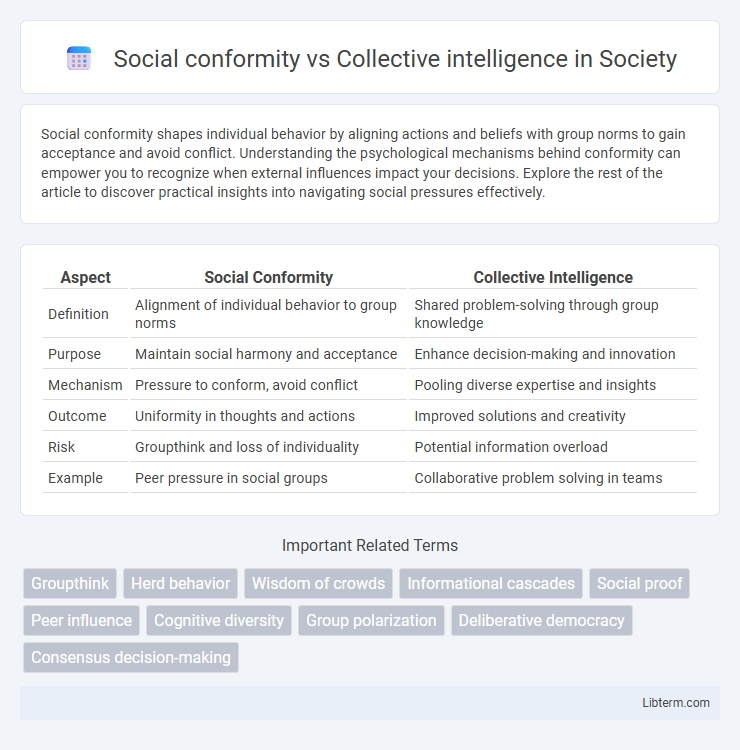Social conformity shapes individual behavior by aligning actions and beliefs with group norms to gain acceptance and avoid conflict. Understanding the psychological mechanisms behind conformity can empower you to recognize when external influences impact your decisions. Explore the rest of the article to discover practical insights into navigating social pressures effectively.
Table of Comparison
| Aspect | Social Conformity | Collective Intelligence |
|---|---|---|
| Definition | Alignment of individual behavior to group norms | Shared problem-solving through group knowledge |
| Purpose | Maintain social harmony and acceptance | Enhance decision-making and innovation |
| Mechanism | Pressure to conform, avoid conflict | Pooling diverse expertise and insights |
| Outcome | Uniformity in thoughts and actions | Improved solutions and creativity |
| Risk | Groupthink and loss of individuality | Potential information overload |
| Example | Peer pressure in social groups | Collaborative problem solving in teams |
Understanding Social Conformity: Key Concepts
Social conformity involves individuals adjusting their behaviors or beliefs to align with group norms, driven by the desire for acceptance or fear of rejection. Key concepts include normative influence, where people conform to be liked, and informational influence, where individuals conform because they believe the group has accurate information. Understanding these mechanisms helps distinguish social conformity's impact on collective decision-making from the benefits of collective intelligence, where diverse ideas enhance problem-solving.
Defining Collective Intelligence: A Group Perspective
Collective intelligence refers to the enhanced capacity created when individuals collaborate, share knowledge, and integrate diverse skills to solve problems or achieve common goals more effectively than any single member could. It emerges from the dynamic interactions and complementary expertise within a group, leveraging varied perspectives to foster innovation and informed decision-making. Unlike social conformity, which pressures individuals to align with majority opinions, collective intelligence thrives on the active contribution of unique insights and critical thinking to optimize group outcomes.
Psychological Mechanisms Behind Social Conformity
Social conformity arises from psychological mechanisms such as normative influence, where individuals align their behaviors to gain social acceptance, and informational influence, where people conform based on the belief that others possess accurate knowledge. The human brain often uses heuristic processing to quickly adopt group norms, reducing cognitive load but sometimes leading to conformity bias. These mechanisms can suppress individual creativity, contrasting with collective intelligence which thrives on diverse, independent contributions.
Factors Influencing Collective Intelligence in Groups
Factors influencing collective intelligence in groups include diversity of skills, effective communication, and balanced participation among members. Social conformity can hinder collective intelligence by suppressing unique perspectives and promoting groupthink, reducing problem-solving abilities. Optimal group performance emerges when individual contributions are valued and critical thinking is encouraged.
Social Conformity: Benefits and Pitfalls
Social conformity fosters group cohesion and smooth decision-making by aligning individual behaviors with shared norms, which can enhance teamwork and social stability. However, excessive conformity risks suppressing creativity and critical thinking, leading to groupthink and poor outcomes in problem-solving. Balancing social conformity with independent thought is essential for leveraging collective intelligence effectively.
How Collective Intelligence Drives Innovation and Problem-Solving
Collective intelligence harnesses diverse perspectives and expertise from group members, leading to innovative solutions and effective problem-solving beyond individual capabilities. By promoting open collaboration and knowledge sharing, it mitigates the limitations of social conformity, which often suppresses unique ideas to maintain group harmony. This dynamic enables organizations to adapt quickly, optimize decision-making, and foster creativity in complex environments.
The Tension Between Groupthink and Independent Thought
The tension between groupthink and independent thought often arises when social conformity pressures suppress diverse viewpoints, hindering collective intelligence. Groupthink fosters consensus at the expense of critical analysis, leading to poor decision-making in organizations or communities. Encouraging individual creativity and dissenting opinions enhances collective problem-solving by integrating varied perspectives and reducing cognitive biases.
Real-World Examples: Social Conformity vs. Collective Intelligence
Social conformity often leads groups to follow majority opinions even when incorrect, exemplified by the Asch conformity experiments where participants agreed with false judgments to fit in. In contrast, collective intelligence harnesses diverse perspectives and expertise, as seen in Wikipedia's collaborative editing process that produces accurate and constantly updated information. Real-world scenarios like jury deliberations demonstrate how collective intelligence can overcome individual biases, while social conformity in corporate settings sometimes stifles innovation and critical thinking.
Enhancing Collective Intelligence While Reducing Blind Conformity
Enhancing collective intelligence requires fostering diverse perspectives and encouraging critical thinking within groups to avoid the pitfalls of blind social conformity. Implementing structured decision-making processes and promoting open dialogue helps balance individual inputs, leading to more innovative and accurate outcomes. Technologies like collaborative platforms and data analytics further support aggregating diverse insights while minimizing conformity bias.
Future Implications: Social Dynamics and Intelligent Collaboration
Social conformity can limit innovation by promoting uniform thinking, whereas collective intelligence harnesses diverse perspectives to drive smarter decision-making and adaptive problem-solving. Future social dynamics will increasingly favor intelligent collaboration platforms that amplify group wisdom while mitigating conformity pressures. Emphasizing collective intelligence in organizational and technological design will enhance resilience and creativity in complex, interconnected systems.
Social conformity Infographic

 libterm.com
libterm.com